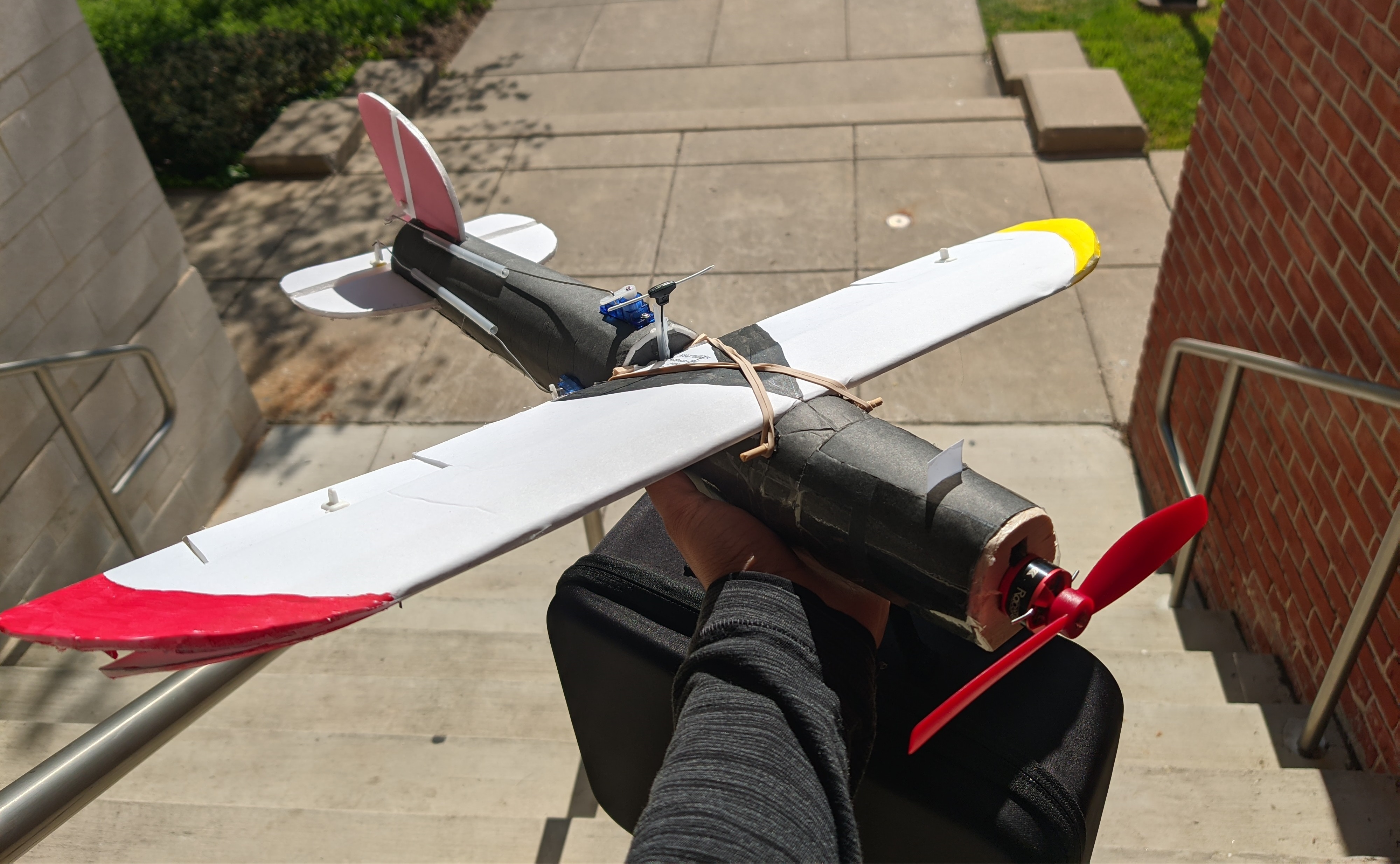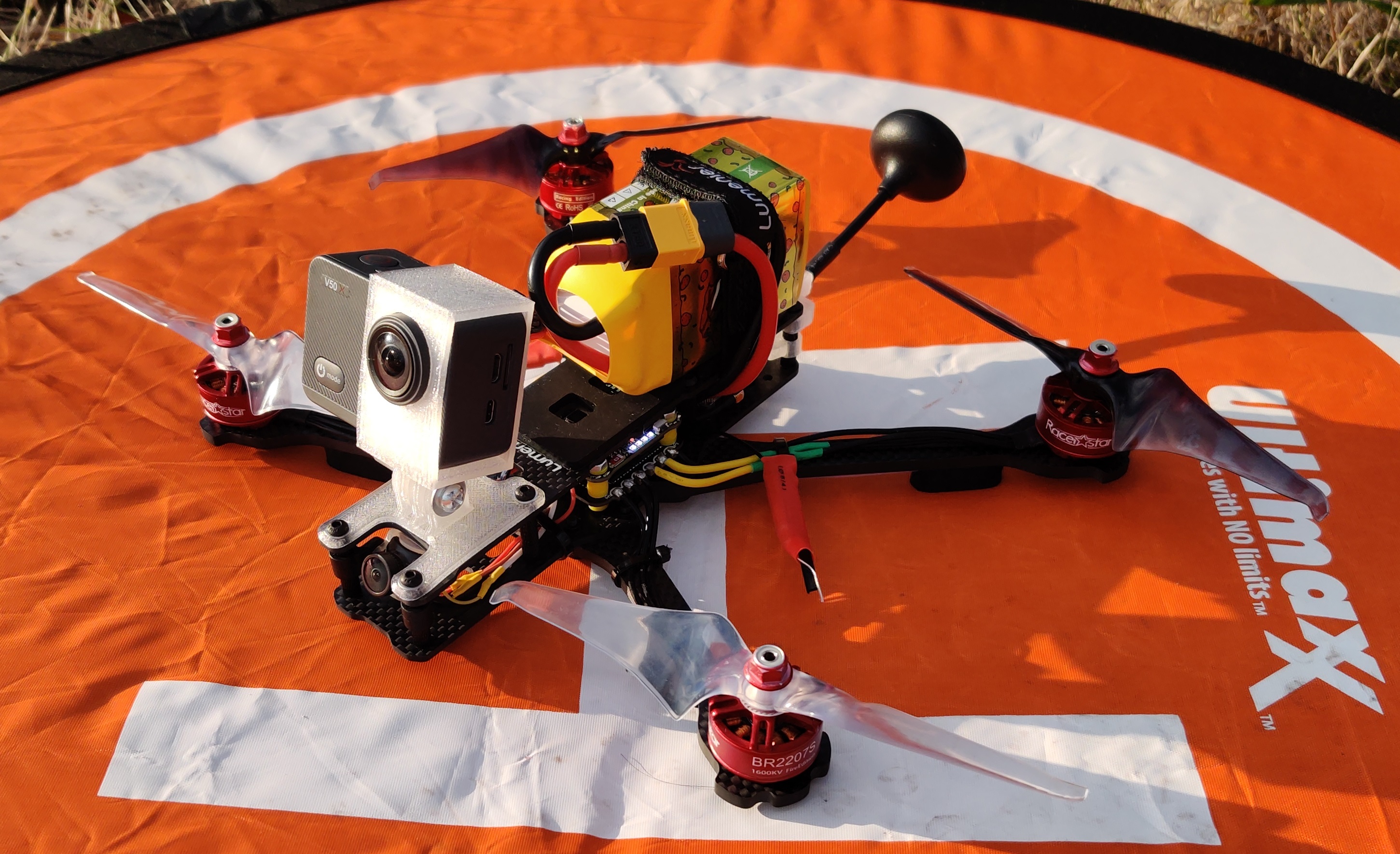Unmanned Aerial Vehicles (UAVs)
 Scratch built sub-250g acrobatic 'Dovetail Mini Warrior'
Scratch built sub-250g acrobatic 'Dovetail Mini Warrior'
On weekend afternoons, I enjoy walking to the local empty grass field, conduct pre-flight checks, and hand launching my remote-controlled (RC) airplane(s) into the air.
My passion for drones taught me the knowledge and skills to custom design model airplanes from scratch, gather construction and electronic components on a budget, and fly fixed-wing aircraft and quadcopters without any assistive features.
I believe UAVs are a valuable resource for both engineering education and scientific research.
Drones provide various rigors of expertise. Simple foam airplanes can be built for under $100 with minimum technical skills to inspire middle and high school students into the field of engineering. More advanced drones such as payload carrying vehicles and VTOLs provide a gateway for college students to utilize their course experiences.
In research, drones are used by geographers to survey large fields, robotics scientists to develop new control algorithms, and by aeronautical engineers to find better propeller blades designs that minimize noise.
Getting Started: Beginner RC Plane
This section is meant to be a guide for a beginner who wants to build an aircraft on a budget. Things that will be covered are:
- Pre-existing beginner guides
- Tools purchase list
- Parts purchase list
- HobbyKing: Great place for wheels, propellers, and motors. Has many other airplane materials, but they are often expensive or out of stock.
- getfpv: Great for quadcopter and FPV parts. They also have great small propellers and batteries.
- Banggood: RC on a budget. I use this commonly if I am in no rush (shipping and delivery times are very long), there are no cheaper option, and if the item is not too expensive. Always read the reviews before making purchases here.
- AliExpress: For items not found at a low cost from any of the above websites. This is the best place to purchase open source and/or generic lightweight items (such as ELRS receivers, Arduinos, etc.). Like Banggood, this is based in China; expect long shipping times and only purchase from stores that have a rating of 97% and have been open for more than 2 years.
- Ebay: Similar to AliExpress, but far better delivery times and reliability.
- FliteTest Store: Really great place for kits and many DIY models. They have build videos for many of their products, so it is very hard to go wrong.
- Amazon: I don't think I have to explain this one.
- Dollar Tree (in person): Purchase foam boards, dowels, paint, etc. from here. For foam board, ONLY purchase them from Dollar Tree! Other brands (Elmer's, Ross board, etc.) are significantly heavier!
Pre-existing beginner guides
If you get tired of my guide, there exists other tutorials on getting into this hobby. The best and most useful, in my opinion, is FliteTest's Beginner Series . I personally used their beginner series and found it to be very informative yet easy to watch. Here's a link to one of their build videos: Flite Test Tiny Trainer . There is also the Joytrainer Mini that you can try.
Tools purchase list
The largest cost in getting into the hobby is the initial cost due to tools. However, keep in mind that you only need to buy these tools once. Additionally, these tools are helpful for other projects such as robotics, electronic repairs, and power supply. Here's a list of non-electric tools to purchase:
- Needle nose pliers (make sure that they can have the wire cutter section)
- Size 11 craft knife (also known as x-acto knife)(make sure to get lots of blades)
- Full sized glue gun and glue sticks (higher wattage rating is generally better)
- Pencils and 2 measuring rulers (one should be dual units (metric and imperial), and the other should be a yard or a meter long)
- Screwdrivers (Phillips head and hex head mainly)
Battery charger
You will need a dedicated battery charger for the lithium batteries. I personally use HTRC C150 because it is cheaper than other options, and comes with adapters and a battery bag. If you want to purchase any other charger, ensure that they are able to 'storage discharge' batteries and have multiple failsafe options. If you know you will be more involved in this hobby, or are planning on flying quadcopters, I have used and recommend the HTRC D240.
Radio transmitter
A radio transmitter (TX) is needed to control the aircraft. Keep in mind that a receiver (RX) is needed alongside. Here are a few options:
- FlySky FS-i6X if you are on a very tight budget and do not intend on flying drones or any other advanced aerial vehicles. I recommend the FS-iA6B receiver for this.
- FrSky QX7 (ACCST) if you can find this second hand or on a discount. Although I personally use this, I do not recommend it as this is rather outdated.
- Radiomaster Pocket (ELRS version). I recommend this transmitter if you are on a tight budget, intend to travel with your drones, or have small hands. However, if you plan on doing advanced aerial vehicles, I would rather go for the Boxer or TX16S.
- Radiomaster Boxer (ELRS version). I highly recommend this transmitter due to its middle ground between high functionality and simplicity. Joshua Bardwell did a review that showcases this transmitter.
- Radiomaster TX16s Mark II (ELRS version) if you are sure you plan on doing high level remote-control in the future.
For ELRS, make sure to get the 'FCC' version. Any ELRS receiver can work with any ELRS TX. However, for airplanes, you will typically want to get a PWM ELRS RX with at least 4 usable PWM pins. Example brands for the PWM ELRS RX include: Radiomaster ER series, Mateksys, and Betafpv.
Solder station
As you progress, you will need a solder station since many RC parts come unsoldered. When purchasing a solder station, make sure that it
- has temperature control, and
- comes with different tips (especially a bevel or chisel tip).
- Sponge or brass wool
- Leaded solder
- Helping hands
- Solder sucker or solder wick (in case you need to remove solder)
Parts purchase list
Some general parts to purchase are:
- Hoop and loop tape (also known as velcro)
- Rubber bands (assorted recommended)
- Heat shrink (I recommend 3:1 shrink ratio)
- Zip ties
- Glue sticks for the glue gun
- Battery tester
- Propellers
Building plans: Trainer Airplane
My recommendation to get started with RC airplanes is to purchase the items listed in this spreadsheet . I already added links to the purchases, however, you can easily find alternatives. Only the motor mount has to be 3D printed, preferably with PETG (other materials work, however they come with their own disadvantages). The 3D printable file for this can be found here.
The plans for the work can be found: (to be completed)
Dovetail Firestyle: A cinematic/freestyle 6" quadcopter
 Dovetail Firestyle on her maiden flight
Dovetail Firestyle on her maiden flight
Dovetail Firestyle (DT-FS) is an all-rounder quadcopter that is intended to be (mostly) budget friendly and feature rich. Maximum speed achieved (and that I was willing to go to) on the DT-FS was 85 mph. The hovering flight time is 7 minutes with an action camera mounted. Since this quadcopter has 'some' long-range capabilities (due to the use of ExpressLRS radio and 800 mW VTX), a GPS is present for return-to-home in case of emergencies. The beeper activates in the event of a crash even when there is no power to the quadcopter.
The parts needed for construction are available here; in case the links expire at the time of viewing, you can search the item using their name or find a similar alternative. The build should cost no more than $400. I 3D printed TPU mounts: an action camera mount and a GPS mount. Use zip ties to secure everything to place, and heat shrink with zip tie to protect and align the receiver antennas.
This page was last updated on December 9, 2024